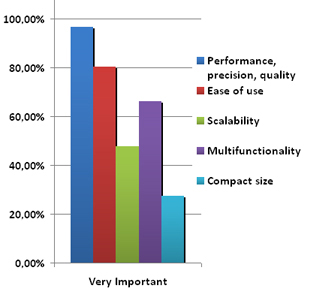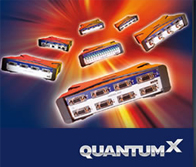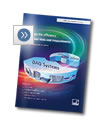
Trends denote changing market for DAQ equipment
A global survey of data acquisition trends has provided a valuable insight into the market
The world of data acquisition and analysis is changing rapidly as companies seek to launch products with markedly reduced development time and with increasingly complex technologies. Often the cry goes up that smart measurement technology requiring relatively unskilled staff is needed to achieve these goals. Efficiency and saving costs are industry’s war cry; its slogan reduced production cycles with consistent quality.
To gain a better insight into the market and how it is evolving, HBM – the global leader in data acquisition and analysis – recently undertook an international survey in seven languages – French, Portuguese, Chinese, Japanese, Korean, German, and English – to ensure maximum participation. This was one of the first surveys of its type and it generated a strong response with nearly 600 replies from professional engineers answering 16 questions covering a range of topics such as the type of equipment used and what options and features were important.
The general trends emerging indicated that the needs of DAQ users worldwide are very similar although there were some slight differences between Europe, the Far East and the Americas. One key message that emerged was the need for companies to provide a global service to meet the needs of customers operating on a worldwide basis.
The most important features: Ease of use, performance, precision and quality
Ease of use and performance, precision and quality were considered the most important features in a DAQ system with 80% of respondents highlighting ease of use and the other aspects scoring 96.5%.
Another aspect that was considered important was the multi-functional capability of any DAQ equipment to handle different measurement quantities with 66.1% of all respondents feeling that this was an important issue. This is in keeping with the perception that the market requires smart measurement technology and closely aligns with HBM’s philosophy of integrating TEDS (Transducer Electronic Data Sheet) and APM (Advanced Plug & Measure) into its DAQ equipment.
These results are broadly similar in all countries surveyed although Japanese engineers rated ease of use as the most important feature in a DAQ system rather than the actual performance of the equipment. This was interesting as previous surveys of DAQ equipment in the country has indicated that Japanese manufactured equipment is better known for its performance rather than for its user friendliness.

Figure 1: Most important features of a DAQ system
(multiple choice was possible)
Configuration: Mobile data acquisition offers flexibility
In terms of the way equipment is configured there was a clear preference across all countries to use a PC for data acquisition and configuration with 85.6% of all respondents believing this was the best method; in the UK the figure was nearly 93%.
Alternative methods for data acquisition and configuration such as using integrated controlsor storage within the instrument/data logger were less than half as popular as using a PC with the instrument/data logger generally considered more popular.
These results would seem to be in line with the changing demands for greater flexibility in data acquisition since the PC is a more mobile, yet robust, option for gathering data and either analyzing it on the PC or transferring it elsewhere for further analysis.
Most popular interfaces: USB and Ethernet
This trend is reflected in the type of interface that engineers prefer with the two PC interfaces –USB and Ethernet – being considered roughly of equal importance with over 60% of respondents preferring these methods.
However, both digital I/O and analog output were very close behind in popularity at just under 60% each. This suggests that engineers have a slight preference for PC interfaces but there is still sufficient demand for DAQ equipment to be able to utilize a wide range of interfaces.
By contrast the relative importance of fieldbus interfaces was only of interest to 40.5% of respondents; in the USA the number of engineers that felt fieldbus interfaces were either less important or not very important was nearly double the numbers that felt it was an important interface.
From these results it might be reasonable to anticipate that there would be a clear trend showing that mobile applications were increasingly important. Overall 33.8% of engineers were involved with mobile applications although this rises to nearly 50% in the USA, Germany, China and France although experimental stress and structural analysis, along with laboratory tests of materials and components, were globally the most popular applications.
Figure 2: Most important interfaces of a DAQ system
(multiple choice was possible)
Power supply from the mains
Perhaps unsurprisingly a power supply from the mains at 73.2% remains the most popular although alternative power supplies such as an on-board vehicle network, DC voltage, and a separate battery supply are all considered roughly of equal importance. The popularity of the PC is underlined here as well since 33.5% of all respondents utilise power direct via the USB port. This aligns closely with the numbers in mobile applications.
Centralized and distributed units for mulitpoint measurements
The underlying trend that further emphasizes to need for the PC is the popularity – at 43.3% – for a mixture of centralized and distributed units for multipoint measurements compared with 29.6% for a centralized system and 16% for a pure distributed system on a world-wide basis. The USA is slightly different in that both centralized systems and a mixture of centralized and distributed units are considered equally important. This meets with HBM’s aims of providing equipment that can easily be integrated into both centralized and distributed systems as well as a mixture of the two.
Application area: Laboratory and industry
Most DAQ equipment is used in either a laboratory or in an industrial setting where the ambient conditions can be easily regulated although 38.7% applications are deployedoutdoors or in a vehicle where ambient conditions are frequently more variable. This is consistent with the numbers stating that their applications are purely mobile as there are a number of static outdoor applications as well.
The ability of DAQ equipment to perform in extreme ambient conditions – such as HBM’s SoMat range of equipment – is underlined by the fact that 18% of DAQ tests are conducted in ambient temperatures of greater than 60°C (140°F) while 10.7% are in very cold temperatures of less than -20°C (-4°F).
Versatile software options
Engineers use a range of software options although proprietary software is a less popular option.
The new mega-trend: High channel counts
A strong trend towards high channel counts has been shown especially in the USA where 19.2% of all measurements utilize a channel count of between 32 and 64 channels while a further 22.2% are for more than 64 channels; this compares with the global rates of 14.1% and 11.2% for the same channel count bands.
Equally there is a clear need for accurate equipment with 40.8% of respondents requiring accuracies of up to 0.1% of the measured value while 20.8% require a greater accuracy of 0.05% of the measured value although these variations might be influenced by the numbers of replies to this question.
One clear trend with significant implications is the constant increase in the number of channels is a clear mega-trend seen in the DAQ industry. According to HBM’s analysis, most countries will follow the USA by adding more and more channels to their measurements. The higher number of channels being demanded does not imply any moves towards lower accuracy: ever higher standards of accuracy are demanded from the engineers.
The markets worldwide demand precise data acquisition systems, which are versatile and scalable. A typical proto-type of such a modern system is HBM’s latest QuantumX data acquisition system.
High sampling rates are a must
Most engineers utilize sampling rates up to 10,000 samples/sec while a significant number – 11.3% - utilize sampling rates of more than 50,000 samples/sec. By contrast only 3.8% of respondents identified low sampling rates of less than 10 samples/sec as their primary area of interest.
Plugs: From the screw terminal through to the RJ plug
DAQ equipment is connected with a wide array of different plugs and the common screw terminal or stranded wire connection is still commonly used with 38.5% of respondent saying that they used this plug. The BNC plug at 36.3% is nearly as popular worldwide although 53.7% of users in the USA prefer this plug. Equally the RJ plug appears to be gaining in popularity.
HBM says, “We’re very impressed by the initial results since they show some clear trends as well as some interesting regional differences impacting on the future development of data acquisition and analysis.”



